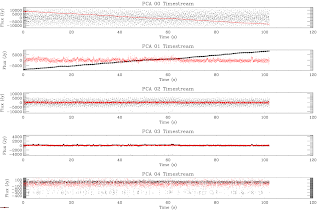One item I forgot to mention last night was the effects of lines/delining on PCA subtraction. These should be the primary effects on the final map for all epochs except 2010, in which case the primary effect SHOULD be to reduce substantial noise. In the examples below, there are PSDs of whole timestreams (left) and example timestreams from single scans (right). The first thing to note is that the delined timestreams still have correlated components in the line region, but they are suppressed - their amplitudes, and therefore their sort order in the PCA removal scheme, are changed. Since PCA cleaning is by its nature adaptive (the number of components remains fixed, but the order changes), these effects can be significant and dangerous. If the line noise is more correlated, a PCA component will be dedicated to removing it instead of atmospheric signal. Below are examples from l089 (epoch 0709) first. These have less correlated line noise and are more typical of BGPS observations. The first PCA component, the average, does not change much with PCA cleaning. However it is clear that the second component changes substantially, from large-amplitude high-frequency noise to small-amplitude variations that are very likely to describe atmosphere.
Example 1 - Zeroing out the lines:


Example 2 - Fitting and removing the lines:


Example 3 - Suppressing the lines with a non-fitted Gaussian:


The next examples are from December 2010 observations of Uranus. In this case, the correlated noise component is clearly dominant.
Zeroing lines:


Fitted lines:


Non-fitted gaussian suppression:


Finally, these two are demonstrations of what you might expect to see for a purely noiseless images of a planet (it was constructed from a PSF). PCA is first:


A single bolometer's timestream and PSD:

